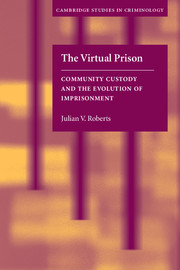Book contents
- Frontmatter
- Contents
- List of figures and tables
- Foreword by Andrew Ashworth
- Preface
- 1 Introduction to the concept of community custody
- 2 The way we punish now
- 3 Conceptualizing community custody
- 4 Representative models of community custody
- 5 Coming home to prison: offender perceptions and experiences
- 6 The effect of community custody on prison admissions
- 7 Public attitudes to community custody
- 8 Making community custody sentences work
- Notes
- References
- Index
6 - The effect of community custody on prison admissions
Published online by Cambridge University Press: 07 December 2009
- Frontmatter
- Contents
- List of figures and tables
- Foreword by Andrew Ashworth
- Preface
- 1 Introduction to the concept of community custody
- 2 The way we punish now
- 3 Conceptualizing community custody
- 4 Representative models of community custody
- 5 Coming home to prison: offender perceptions and experiences
- 6 The effect of community custody on prison admissions
- 7 Public attitudes to community custody
- 8 Making community custody sentences work
- Notes
- References
- Index
Summary
Although as noted in chapter 3, community custody aims to achieve multiple sentencing aims, home confinement regimes have usually been introduced in order to reduce the number of prisoners in custody (e.g. Law Reform Commission of New South Wales, 1996; Daubney and Parry, 1999). This chapter explores a critical question regarding community custody: can the sanction actually achieve this goal? Will creation of this sentence result in a widening of the net, as a result of being applied to offenders who otherwise have received a non-custodial sanction? The experience with some other alternatives to imprisonment has been disappointing – the trends with respect to the use of imprisonment reviewed in chapter 2 attest to this fact. However, the limited data regarding community custody are more positive. In jurisdictions such as New Zealand it is too early to know whether community custody is an effective tool to reduce the number of admissions to custody. In these countries, community custody either is too new an innovation, or has not been sufficiently widely implemented to make a difference to custodial populations. The experience in Canada and Finland yields the clearest (and most positive) findings in this regard, and accordingly will be explored in more detail.
Although no comprehensive international review has been conducted, researchers have concluded that there is little evidence that decarceration is a consequence of the creation of a community custody sanction.
- Type
- Chapter
- Information
- The Virtual PrisonCommunity Custody and the Evolution of Imprisonment, pp. 116 - 130Publisher: Cambridge University PressPrint publication year: 2004



